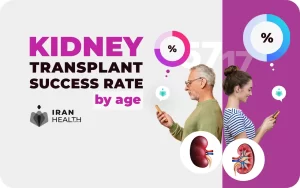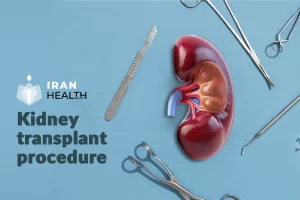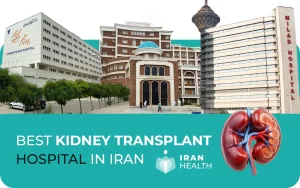Detailed description
Disparities in kidney care are characterized by discrepancies in the incidence, classification, management, and results of end-stage kidney disease (ESKD) and chronic kidney disease (CKD) across racial, ethnic, socioeconomic, and geographical categories. The intricate interaction between biological, environmental, behavioral, and health system factors impacts the health and well-being of both people and populations, and these disparities are a reflection of that. Disparities in kidney treatment are a big deal because they raise the costs of treating kidney disease, the risk of death, and the burden on families and communities dealing with this illness.
If you are looking for a kidney transplant in Iran, reading this article in detail can be useful.
Kidney care discrepancies in the US and around the world are the focus of this article, which aims to investigate the problem, its effects, and potential remedies. The following research questions will be specifically addressed in the paper:
When it comes to kidney care, why do certain demographics and geographic areas have more gaps than others?
How do inequalities in renal care affect the well-being, prognosis, and medical treatment adherence of people with kidney disease and those who care for them?
When it comes to kidney health, what are the most effective strategies for achieving greater fairness and decreasing or eliminating healthcare disparities?
In this blog, we will examine the existing research on kidney care disparities from a variety of fields, including policy, sociology, economics, psychology, and epidemiology. Additionally, the article will point out where current research falls short and provide recommendations for where to go from here in terms of both studies and activities. This paper surveys recent work on kidney care inequities, both in terms of theory and practice. It also concludes and makes recommendations about how to make renal care better for everyone.
Read more: Long-term health impacts of kidney disease beyond dialysis and transplant
Factors contributing to disparities in access to kidney care and transplant
Socioeconomic Inequities
- Low social and economic standing is associated with greater commonness of chronic renal illness and end-stage renal disease danger factors like diabetes and high blood pressure.
- Limited availability and affordability of preventative services, medicaments, and dietary interventions for renal illness management occur with low socioeconomic status.
- Inferior eligibility and referral for renal transplants result from low socioeconomic status due to reasons like absence of medical coverage, incapacity to meet charges, minimal social assistance, and poor health literacy.
Geographic Inconsistencies
- The site regulates the access and ease of use of renal care resources, specialists, and facilities.
- Rural zones possess fewer renal care suppliers and centers, resulting in prolonged travel durations and expenses for patients.
- Location impresses deviation in metrics across different areas like prevalence and occurrence of end-stage renal disease, use of home dialysis, wait times and mortality for transplants, and graft endurance percentages.
Racial and Ethnic Incongruities
- Racial and ethnic minorities exhibit higher chronic kidney disease and end-stage kidney disease percentages compared to non-Hispanic whites.
- Inequities somewhat result from the superior prevalence of genetic and environmental risk factors among minorities.
- Inequities also demonstrate the influence of social determinants of wellness like unfair treatment, racism, deprivation, education access, and medical care availability on renal health.
- Inferior referral and evaluation percentages plus prolonged wait times signify some of the barriers minorities face in obtaining optimal renal care and transplants.
The following table provides a more detailed view of the data.
Key point table:
| Factor | Impact on Kidney Disease | Specific Examples |
| Socioeconomic Status (SES) | Increased risk of CKD and ESKD risk factors (diabetes, hypertension, obesity) | Limited access to preventative care, diagnostic tests, medications, and dietary interventions due to cost or lack of insurance, which can worsen existing conditions and increase the risk of developing kidney disease |
| Geographic Location | Limited access to kidney care facilities, specialists, and resources, especially in rural areas | Longer travel times and costs for consultations, dialysis appointments, or transplant procedures, can delay diagnosis, treatment, and adherence to care plans |
| Race/Ethnicity | Higher rates of CKD and ESKD compared to non-Hispanic whites, partly due to genetic and environmental risk factors, and social determinants of health | Genetic factors like APOL1 gene variants in some populations, higher prevalence of environmental risk factors like diabetes and hypertension due to social determinants of health (discrimination, poverty, limited access to healthy food and quality healthcare), and lower rates of screening and early diagnosis |
Barriers to accessing kidney care and transplant
Because of its exorbitant cost, kidney care and transplants are out of reach for many low-income and uninsured patients. Patients’ ability to afford and gain access to prescription medications, dietary supplements, specialists, general care, and preventive treatments is influenced by their insurance. The ability to receive immunosuppressant medications and post-transplant care, including follow-up visits and eligibility for kidney transplants, is dependent on insurance coverage. Increased out-of-pocket expenses due to transplant evaluation and listing process delays or rejections might put patients without sufficient insurance in a tough financial position.
Patients in outlying locations confront additional challenges while seeking renal treatments or transplants due to the difficulty of gaining access to healthcare facilities. If there are not enough renal clinics and specialists in the area, these patients may have a harder difficulty getting the care they need because of the longer travel times and higher transportation costs. Organ donation organizations, dialysis centers, referring physicians, transplant teams, and the general public all have increased difficulty in coordinating patient care when people face barriers to accessibility. Kidney transplant referral, evaluation, and listing rates are all negatively impacted for patients residing in rural or distant areas. Additionally, these patients may face longer wait times and lower total transplant rates.
Immigrants, refugees, and people of color face enormous language and cultural hurdles that make it very difficult for them to receive kidney transplants and treatment. Healthcare providers may find it challenging to communicate with these patients and help them grasp their medical conditions, treatment plans, and available alternatives. The level of trust and rapport between patients and doctors, as well as patients’ expectations and decisions about kidney therapy and transplant, might be impacted by language and cultural difficulties. Potential living donors may be hard to come by due to language and cultural obstacles; this is particularly true for those of the same religious or ethnic origin as the recipient. Kidney transplant awareness, education, consent, and live donor transplant rates may be lower for patients who face language and cultural obstacles.
Key Points on Barriers to Kidney Care:
| Factor | Barrier | Impact on Patients |
| Socioeconomic Status (SES) | Inability to afford care and transplant | * Limited access to preventive care, specialists, medications, and dietary support * Delays or rejections in transplant process * Increased financial hardship |
| Geographic Location (Rural & Remote) | Limited access to healthcare services | * Longer travel times and higher transportation costs for care * Difficulties receiving timely and high-quality care * Challenges in coordinating care between providers and accessing transplant resources |
| Language & Cultural Barriers | Difficulty understanding information and communicating with healthcare providers | * Confusion about medical instructions and choices * Difficulty expressing needs and preferences * Lower trust and rapport with doctors * Reduced awareness and education about kidney transplants |
Strategies to address disparities in kidney care and transplant
Approaches to Mitigate Inequalities
- Furthering Understanding and Education
- Enhance early detection, diagnosis, referral, evaluation for transplantation
- Increase comprehension and acceptance of transplant as therapy alternative
- Expand availability and inclination of living contributors
- Campaigns by kidney foundations, Centers for Disease Control, Health Resources and Services Administration, American Society of Nephrology
- Bettering Admittance to Preventative Services and Checkups
- Assist in impeding/postponing renal illness progression
- Identify/attend to co-existing diseases and complications
- Refine eligibility and preparedness for transplant
- Refine post-operation outcomes
- Involvements under Medicare coverage
- Employing Regulations to Lessen Disparities in Entrance to Transplant
- Generate a more impartial and proficient structure for organ allotment
- Resolve financial and community obstacles
- Increase supply and employment of donor organs
- Perfect quality and outcomes
- Standards, incentives concerning organ procurement, allocation, living donation, insurance, integrated care prototypes
Examples of effective treatments and case studies
In this part, we will take a look at several initiatives and examples of good practice that have reduced kidney transplant and care disparities. Changes in municipal and federal laws, healthcare provider partnerships with community groups, and community-based programs that help low-income populations are all examples of interventions.
- community-based initiatives that aim to support marginalized groups
In South Carolina, for instance, there is a program called the Kidney Education Outreach Program (KEOP) that aims to help underprivileged communities. Since African Americans are disproportionately affected by end-stage renal disease (ESKD) and have a lower propensity to undergo kidney transplants, this campaign seeks to raise awareness about these topics among this population. Community health workers offer a wide range of services to people and families affected by chronic kidney disease (CKD), including culturally relevant information, counseling, and referrals to transplant centers and nephrologists. With the help of area schools, churches, and other community organizations, the program hosts health fairs, screenings, and workshops. The initiative does more than only increase patients’ happiness and access to renal care; it also changes their perspective on kidney disease and transplantation.
An example of a community-based initiative that aims to assist neglected regions is the Transplant Education Program (TEP) in California. Since the donation rate is lower among Hispanic patients with ESKD compared to non-Hispanic whites, this program seeks to raise knowledge and acceptance of living donor kidney transplants among this population. Individualized support and information is given to patients and their families by bilingual transplant coordinators. Having peer mentors and role models present at group meetings who have also undergone a living donor transplant enhances the experience. In addition to collaborating with local news organizations, health clinics, and nonprofits, the initiative’s arsenal includes media campaigns, videos, and pamphlets. Patients’ engagement, openness, and comprehension of living donor transplants are all improved by this method.
- Collaborations between local groups and healthcare providers
As an illustration of a collaboration between community groups and medical experts, consider the Kidney Transplant Learning Center (KTLC) in New York³. Since persons of color lag behind whites in these areas, this alliance aims to improve their access to and quality of kidney transplant education and evaluation.
Patients and their families are supported throughout the process by a multidisciplinary team that includes social workers, community health workers, and transplant specialists. This team provides culturally competent counseling, education, and referrals to other services, such transplant clinics.
To raise awareness about kidney transplants among medical professionals and patients, the alliance works in tandem with community groups, patient advocacy groups, and dialysis centers to host outreach events like webinars, seminars, and publications. In addition to increasing patients’ access to and completion of transplant evaluations, there is evidence that this relationship enhances patients’ overall comprehension of kidney transplantation.
Among healthcare providers and community organizations that have formed partnerships is the Improving Renal Outcomes Collaborative (IROC) in Ohio. Kidney illness and transplant are disproportionately common among children from low-income and rural regions, so this collaboration is focused on improving patient outcomes and quality of life in those populations. To improve the quality of about treatment that patients and their families get, collaborators contribute details about pediatric nephrology centers, dialysis units, transplant centers, and primary care physicians.
Community people, patients, and their families are being actively involved in the effort to learn more about the difficulties of kidney care and transplantation so that problems can be better understood and solved. Growth, graft function, blood pressure, and patient satisfaction with kidney treatment and transplant are some of the clinical parameters that are improved by cooperation.
- Shifts in federal and state policy
The US Kidney Allocation System (KAS) is an illustration of a shift in government policy. More equitable and efficient distribution of deceased donor kidneys will be implemented as a result of this policy reform, with a focus on patients on the transplant waiting list who exhibit high sensitivity, long waiting durations, or compatible blood types. The previous system was heavily modified in response to this regulatory change. One example is the current method for quantifying sensitization levels, which uses the calculated panel reactive antibody (CPRA) instead of the peak panel reactive antibody (PRA). Donor age is no longer the principal indicator of kidney donation quality; the KDPI has mostly replaced it. Instead of dialysis time, the expected post-transplant survival (EPTS) is now utilized to measure the expected benefit of the transplant.
Read more: Managing Your Kidney Transplant: A Guide to Medications, Monitoring, and Signs to Watch For!
If a candidate’s CPRA is greater than 98%, they will be given precedence when receiving a compatible offer, according to the new policy. Also, people who are B-blooded will have the chance to get A2/A2B kidneys if they so want. Finally, the top 20% of candidates will be offered the kidneys from the best 20% of donors. Based on the data that is now available, it appears that transplant rates have gone up, disparities have gone down, and the overall life and utility of donor kidneys have improved.
The Living Donor Champion Program (LDCP) in Maryland is another evidence that rules can be changed at the local level. That more live donor kidney transplants would be available and used is fantastic news for patients with end-stage renal disease (ESKD), particularly those who encounter cultural and social obstacles when seeking a donor. A close friend or family member of a patient will be trained and given the authority to fight for the patient’s right to receive a live donor as part of the new policy. As part of the new policy, advocates will have access to webinars, workshops, and resources that will assist them reach out to possible donors and dispel donor myths. There has been a policy shift, and now social workers and transplant coordinators will work together to track patients’ and advocates’ progress and help them achieve their goals. Due to the legislative shift, there was a spike in inquiries, evaluations, and transplants from living donors, as patients and advocates alike reported more transparency, assurance, and contentment with the process.
Based on:



